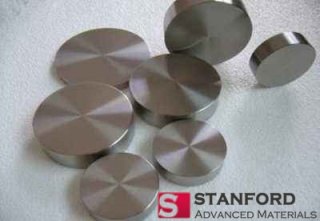Reactive Sputtering of Titanium Target
10 srpanj 2019Reactive sputtering is a common technique for preparing thin films of metal oxides, nitrides, and carbides. In this process, the metal sputtering target is sputtered in a mixture of argon and other reactive gases such as oxygen, nitrogen, methane, and the like. It is advantageous to use a metal target instead of a composite target because it is easier to process the metal, and its target sputtering rate is usually high and the thermal conductivity is good. In addition, complex compounds having polymetallic elements can also be produced using reactive sputtering of metal alloys or by co-sputtering from different elemental targets.
Although reactive sputtering is superior to composite sputtering, reactive sputtering is a nonlinear process and, in most cases, has a hysteresis effect due to target poisoning caused by the interaction of the target with the target and the reactive gas. It may cause charge accumulation and arc discharge. In addition, the sputtering yield is lowered because the binding energy between titanium and carbon atoms is higher than the binding energy between titanium atoms. The formation of a new layer on the surface of the titanium sputtering target results in a decrease in yield and deposition rate.
The synthesis of multi-component nanocomposite or functionally graded membranes by reactive sputtering requires critical control of process parameters. This is because electrical, optical, and mechanical properties can vary with film composition as process conditions change. There is a real need to control process parameters, particularly when it is desired to synthesize films with reproducible chemistries and when film growth occurs in so-called transition regions, with reference to the transition from metal to composite sputtering mode.
Titanium carbide (TiC) is a gap transition metal carbide. TiC and other interstitial carbides are characterized by high hardness, high melting point, low thermal conductivity and significant non-stoichiometry. All transition metal carbides have a very large range of stability and a large number of carbon vacancies. Thus, this formula is commonly written as TiCx, where x refers to the carbon moiety in the compound. The value of x can be varied without any structural change in the range of about 0.47-0.97. This provides considerable room for adjusting the physical properties of the film without structural changes.
Reactive sputtering of titanium targets in argon and methane is an attractive method for depositing Ti-C films having different compositions. However, due to changes in flow rate or partial pressure of methane gas, a sharp transition from metal to composite sputtering mode makes control of one or two parameters critical. Much research has been conducted to investigate the effects of overflow transitions between metal sputtering and reactive sputtering modes using elemental, binary, ternary and/or quaternary alloy targets in the presence of one or more reactive gases. . Various techniques have been used to deposit TiC films, including reactive sputtering, activation reaction evaporation, reactive pulsed laser deposition, and plasma arc deposition. However, there is currently no published study on the hysteresis behavior of direct current (DC) sputtered titanium targets in Ar/CH4 gas mixtures.
For more information, please visit https://www.sputtertargets.net/.
komentiraj (0) * ispiši * #

